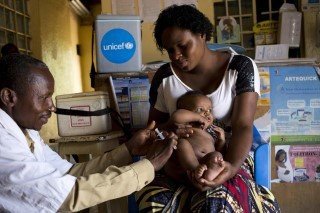Vaccination key facts for professionals
This Vaccination expert centre can benefit anyone but is mostly for Healthcare professionals and Front-line workers who wish to increase their technical knowledge and confidence when interacting with caregivers.
Key messages that everyone has the right to know:
- Vaccination prevents illness, disability and death from vaccine-preventable diseases including cervical cancer, diphtheria, hepatitis B, measles, pertussis (whooping cough), pneumonia, polio, rotavirus diarrhoea, rubella and tetanus.
- Vaccination saves 2-3 million lives each year. By protecting children against serious diseases, vaccines play a central role in ending preventable child deaths.
- The vast majority of parents vaccinate their children. Vaccination is the single best way to protect themselves AND their baby. Global vaccination coverage has remained at 85% for the last 10 years. Lack of progress in Global vaccination coverage - the proportion of the world’s children who receive recommended vaccines – has resulted in the re-emergence of vaccine-preventable diseases such as measles and diphtheria.
- Wherever children are not vaccinated, their lives and their communities are at risk.
- Everyone is responsible for ensuring they are up to date with their vaccinations.

As a healthcare professional and/or front-line worker, you are interacting directly with parents and caregivers. Internet of Good Things is made available to support your interactions with caregivers and families so you can help people make healthy decisions like vaccinating.
How should you talk to them to deliver the message clearly and efficiently so that every child is vaccinated and more lives are saved?
Here are some key best practices for you to reuse:
- Presume Vaccination: Start the vaccine conversation with parent/caregivers using presumptive language such as: “It is time for your child to get vaccinated”, “Now it’s time for Sam’s vaccines” or “Today we’ll give Alex her vaccines”
If there were to be any concerns or someone is hesitant, it is recommended to follow this 5-steps approach for a more effective conversation:
<u>1. Ask open ended questions</u>:
Questions you might ask are : “What are your concerns about vaccinating?”
Open questions using “what”, “why”, “how”, “tell me…” to explore concerns
<u>2. Reflect and respond</u>
Simple reflection: directly repeating what the person says.
Complex reflection: repeating what you think the person means.
Caregiver: “I know vaccinating will help the child but I am afraid.”
Health worker: “I understand that you are afraid.” OR “I understand that you want to make the best choice for your child but are nervous..”
<u>3. Affirm the strengths and validate concerns</u>
When affirming strengths, you might use sentences like : “It’s great that you are starting to think about vaccines.”
When validating concerns, you do not have to acknowledge the validity of the actual concern, but it is important for you to acknowledge the person’s right to have questions. You might use sentences like :“The health of your children is important to you.”
<u>4. Ask-provide-verify</u>
As the conversation evolves, explore the concerns further:
- Ask information on what the client knows about vaccines. Example of a question :“So what do you already know about vaccines?”
- Seek permission to share your knowledge. E.g: “Could I provide you with some information, based on what you just shared?”
- Verify what they have understood and what they will do with this information. E.g :“Given our discussion, how do you view things now?”
<u>5. Summarize and describe action</u>
Summarize the interaction with the parent, caregiver. You might be using sentences such as :“The reason that’s important is…”, “What that means to you is…” OR “The main point to remember is….”
Then determine and describe the action.
IF YES: Vaccinate and offer praise to affirm the positive decision.
IF FOR FOLLOW-UP (if possible): Refer caregiver/patient to a specialist/community advocate or schedule a new discussion: “Let’s revisit this once you have had a chance to think more about vaccination. When could you come back?”
IF REFUSAL: Do not debate. Leave the door open: “I understand. Please know that if you change your mind and want to talk about vaccinating, we are always available.”
If the caregiver/patient’s wishes are NOT to vaccinate, ensure they understand their decision, and explain their responsibilities for protecting the health of their child/themselves.
“I understand that you have decided not to vaccinate today. Please know you are taking an important responsibility. What this means is…
- If your child/you are ill, you must seek medical assistance
- When talking to medical/clinic staff, you must tell them that you/your child has not received all the vaccines recommended.
- You must learn about the signs and symptoms of vaccine preventable diseases.”

IMPORTANT REMINDERS
When applying these approaches, Always ADAPT the communication to YOUR setting, Be sensitive to culture, social norms, religion, level of education, etc.
Emotions matter when building trust. Remember to take into account the feelings and concerns of parents/caregivers:
- Offer the time, space, and the environment for caregivers to digest information and ask questions
- Acknowledge and validate the perceptions of caregivers before advising them
- Demonstrate listening, be authentic and show you care
- Always tell the truth, even if admitting you do not know
<u>DO</u>
- Do take a guiding style.
- Do work with the parent/patient to establish trust.
- Do explore doubts and interest in vaccination. Think from their perspective.
- Do take time to reflect on what the caregiver/patient is saying.
<u>DON'T</u>
- Do not take a traditional directive and argumentative style.
- Do not identify and solve the problem for the parent/patient.
- Do not argue or debate with the client. Make it known that you are there to listen to their concerns.
- Rush through without listening.
Guided conversations should take no more time than usual routine interactions, or perhaps 2-3 minutes longer.
We suggest focusing on one concern during your interaction, discussed in a competent and caring manner.
If more time is needed, ask if the caregiver/patient can wait until after others are vaccinated, or book another visit (if feasible).

OTHER ADVICE FOR EFFECTIVE COMMUNICATION AND INTERACTION WITH PARENTS, CAREGIVERS AND PATIENTS INCLUDE:
- <u>Talk about the disease and the ability parents have to protect their children:</u>
Explain the severity and/or risks of the disease you are vaccinating against and follow severity with self-efficacy by reinforcing the ability parents have to protect their children by stating: “Vaccination is the single best way to protect yourself AND your child”. You will find information about diseases and their severity in the following article “Learn about the different preventable diseases and why vaccination is so important” - <u>Talk about Adverse Events Following Vaccination (AEFI):</u>
Acknowledge the presence of a risk with vaccination (just as there is a risk doing sports, crossing the road, in everything we do in life), and describe briefly the possible (AEFI) insisting on the fact that the risk of an unvaccinated child contracting a disease is much higher than having a vaccine-associated adverse event.
Prepare caregivers, parents and patients to identify, manage, and appreciate minor and temporary local reactions such as a sore arm or mild fever, so there are no surprises or unnecessary anxiety.
You will find information about AEFI in the article “Are vaccines safe?”
- Minimize pain and soothe the baby:To reduce pain and improve soothing, babies should be held in hands by their parents /caregivers during vaccination.
- When and where should I go next? Make sure you specify the date and place of the next vaccination appointment to parents and caregivers
Average Rating: ★ ★ ★ ★ ★ (1 reviews)
Leave Your Feedback
Recent Reviews
Useful information
May 26, 2025, 7:09 a.m.


